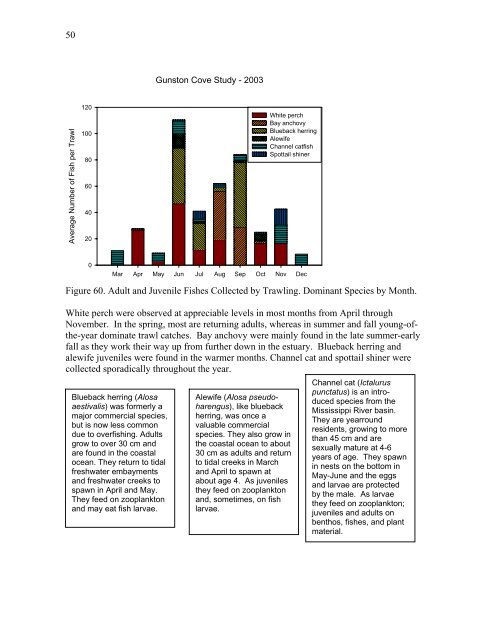NEW: Annual Report - George Mason University
NEW: Annual Report - George Mason University
NEW: Annual Report - George Mason University
You also want an ePaper? Increase the reach of your titles
YUMPU automatically turns print PDFs into web optimized ePapers that Google loves.
50<br />
Average Number of Fish per Trawl<br />
120<br />
100<br />
80<br />
60<br />
40<br />
20<br />
0<br />
Gunston Cove Study - 2003<br />
White perch<br />
Bay anchovy<br />
Blueback herring<br />
Alewife<br />
Channel catfish<br />
Spottail shiner<br />
Mar Apr May Jun Jul Aug Sep Oct Nov Dec<br />
Figure 60. Adult and Juvenile Fishes Collected by Trawling. Dominant Species by Month.<br />
White perch were observed at appreciable levels in most months from April through<br />
November. In the spring, most are returning adults, whereas in summer and fall young-ofthe-year<br />
dominate trawl catches. Bay anchovy were mainly found in the late summer-early<br />
fall as they work their way up from further down in the estuary. Blueback herring and<br />
alewife juveniles were found in the warmer months. Channel cat and spottail shiner were<br />
collected sporadically throughout the year.<br />
Blueback herring (Alosa<br />
aestivalis) was formerly a<br />
major commercial species,<br />
but is now less common<br />
due to overfishing. Adults<br />
grow to over 30 cm and<br />
are found in the coastal<br />
ocean. They return to tidal<br />
freshwater embayments<br />
and freshwater creeks to<br />
spawn in April and May.<br />
They feed on zooplankton<br />
and may eat fish larvae.<br />
Alewife (Alosa pseudoharengus),<br />
like blueback<br />
herring, was once a<br />
valuable commercial<br />
species. They also grow in<br />
the coastal ocean to about<br />
30 cm as adults and return<br />
to tidal creeks in March<br />
and April to spawn at<br />
about age 4. As juveniles<br />
they feed on zooplankton<br />
and, sometimes, on fish<br />
larvae.<br />
Channel cat (Ictalurus<br />
punctatus) is an introduced<br />
species from the<br />
Mississippi River basin.<br />
They are yearround<br />
residents, growing to more<br />
than 45 cm and are<br />
sexually mature at 4-6<br />
years of age. They spawn<br />
in nests on the bottom in<br />
May-June and the eggs<br />
and larvae are protected<br />
by the male. As larvae<br />
they feed on zooplankton;<br />
juveniles and adults on<br />
benthos, fishes, and plant<br />
material.
















